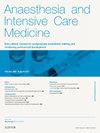Physiology of red and white blood cells
IF 0.2
Q4 ANESTHESIOLOGY
引用次数: 0
Abstract
Blood is made up of plasma and formed elements, which are red blood cells, white blood cells and platelets. The red blood cells (erythrocytes) make up the vast majority of the cells present in the blood. Their principal function is the transport of oxygen from the lungs to the tissues and the transport of carbon dioxide from those tissues back to the lungs. This is due to the presence of haemoglobin, a protein that binds easily and reversibly with oxygen. The affinity of haemoglobin for oxygen changes under certain conditions allowing increased off-loading of oxygen at the respiring tissues as required. White blood cells (leucocytes) form the body's defence against invading pathogens. They can be subdivided into granulocytes and agranulocytes, which have different mechanisms of attack against those pathogens.
求助全文
约1分钟内获得全文
求助全文
来源期刊

Anaesthesia and Intensive Care Medicine
ANESTHESIOLOGY-
CiteScore
0.50
自引率
0.00%
发文量
152
期刊介绍:
Anaesthesia and Intensive Care Medicine, an invaluable source of up-to-date information, with the curriculum of both the Primary and Final FRCA examinations covered over a three-year cycle. Published monthly this ever-updating text book will be an invaluable source for both trainee and experienced anaesthetists. The enthusiastic editorial board, under the guidance of two eminent and experienced series editors, ensures Anaesthesia and Intensive Care Medicine covers all the key topics in a comprehensive and authoritative manner. Articles now include learning objectives and eash issue features MCQs, facilitating self-directed learning and enabling readers at all levels to test their knowledge. Each issue is divided between basic scientific and clinical sections. The basic science articles include anatomy, physiology, pharmacology, physics and clinical measurement, while the clinical sections cover anaesthetic agents and techniques, assessment and perioperative management. Further sections cover audit, trials, statistics, ethical and legal medicine, and the management of acute and chronic pain.
 求助内容:
求助内容: 应助结果提醒方式:
应助结果提醒方式:


